The Fall of the Aztec Empire: Unraveling the Conquest by Hernán Cortés
The story of the fall of the Aztec Empire is a tale shrouded in mystery and intrigue. It is a chapter of history that has captured the imagination of scholars and fascinated the curious minds of individuals around the world. The conquest led by Hernán Cortés, a Spanish conquistador, would forever change the course of history in the Americas. This article aims to delve deep into the events leading up to the fall of the Aztec Empire, exploring the rise of the empire, the motivations of Cortés, the initial encounters and alliances, the siege of Tenochtitlán, and the ultimate destruction of an ancient civilization. Join us on this journey as we uncover the truth behind one of the most dramatic and significant moments in history.
Contents
- The Aztec Empire before the Conquest
- Hernán Cortés: The Conquistador
- The Conquest Begins: Arrival in the Aztec Empire
- The Siege of Tenochtitlán: A Turning Point
- The End of an Empire: Fall of Tenochtitlán
- Legacy and Consequences
- Conclusion
-
Frequently Asked Questions
- 1. What was the significance of the name “Aztec”?
- 2. How did the Aztecs build their impressive city of Tenochtitlán?
- 3. What were the main agricultural practices of the Aztecs?
- 4. How did the Aztecs view warfare and sacrifice?
- 5. Who were the powerful gods worshipped by the Aztecs?
- 6. What was the role of women in Aztec society?
- 7. How did Hernán Cortés gain the support of indigenous allies?
- 8. What role did disease play in the fall of the Aztec Empire?
- 9. How did the capture of Moctezuma II impact the Aztec Empire?
- 10. What were the long-term consequences of the fall of the Aztec Empire?
- References
-
Frequently Asked Questions
- 1. What factors led to the rise of the Aztec Empire?
- 2. How did Aztec society and culture differ from other indigenous civilizations?
- 3. What motivated Hernán Cortés to embark on his journey to the New World?
- 4. How did Hernán Cortés establish alliances with indigenous groups upon his arrival?
- 5. What role did diseases play in the downfall of the Aztec Empire?
- 6. How did Cortés’s battle strategies contribute to the siege of Tenochtitlán?
- 7. What were the consequences of the fall of Tenochtitlán and the colonization of the Aztec Empire?
- 8. How did the fall of the Aztec Empire impact other indigenous peoples and cultures?
- 9. What are some different historical accounts and perspectives on the conquest of the Aztec Empire?
- 10. What is the lasting legacy of the fall of the Aztec Empire?
- References
- Read More
The Aztec Empire before the Conquest
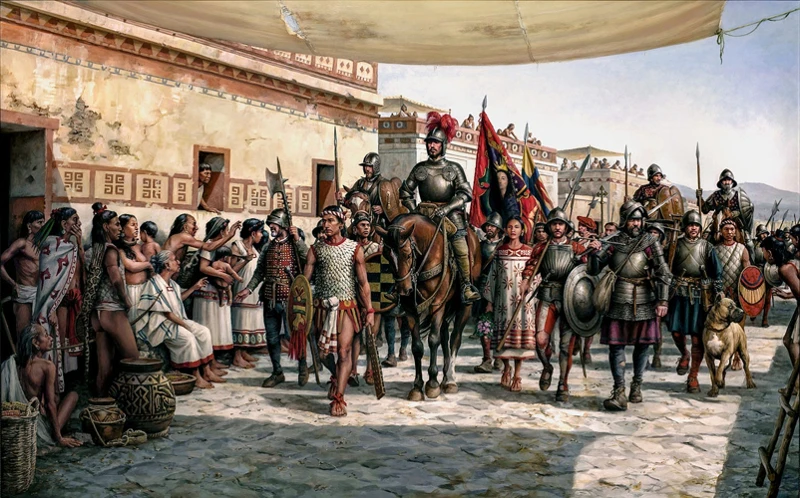
The Aztec Empire, known as Mexica to its own people, was a vast and powerful civilization in Mesoamerica. Before the arrival of the Spanish conquistadors, the Aztecs had established their empire through a series of conquests and alliances. At its peak, the empire spanned from the Gulf of Mexico to the Pacific Ocean, encompassing territories with diverse cultures and traditions. The Aztec society was highly stratified, with a ruling class of nobles and priests at the top and commoners, artisans, and slaves making up the lower rungs. At the heart of Aztec culture was their complex religious beliefs, which included the worship of a pantheon of gods and elaborate rituals. The Aztecs also had a sophisticated agricultural system, utilizing chinampas, or floating gardens, to sustain their large population. Their achievements in architecture, art, and technology were remarkable, with grand structures such as the Templo Mayor in their capital city of Tenochtitlán (modern-day Mexico City). The Aztec Empire was a thriving civilization with a rich history that has left lasting influences on the region. Throughout this article, we will explore the rise and characteristics of this remarkable empire, providing a deeper understanding of the context in which the conquest unfolded.
1.1 The Rise of the Aztec Empire
|
The rise of the Aztec Empire is a fascinating tale of ambition, conquest, and strategic alliances. The Aztecs, originally a nomadic group called the Mexica, arrived in the Valley of Mexico in the 13th century. They settled on an island in Lake Texcoco and gradually built alliances with surrounding city-states. Through military prowess and political maneuvering, the Aztecs expanded their influence over neighboring territories, incorporating them into their empire. One of the key factors contributing to their success was their ability to form alliances through a diplomatic strategy known as the “Triple Alliance.” This alliance, between the Aztecs and two other city-states, Texcoco and Tlacopan, allowed them to strengthen their military forces and exert control over the region. With each conquest, the Aztecs gained wealth and tribute, further solidifying their power. |
1.2 The Aztec Society and Culture
The Aztec society was a complex and hierarchical structure that played a significant role in shaping the empire’s culture. At the top of the social pyramid were the nobles and priests, who held immense power and privilege. The nobles were primarily responsible for governing and leading military campaigns, while the priests played a crucial role in religious ceremonies and maintaining spiritual harmony. Religion was deeply ingrained in every aspect of Aztec life, with gods representing various natural elements and celestial bodies. They believed in the cyclical nature of time and the importance of conducting rituals to maintain the cosmic balance. Human sacrifice was a fundamental aspect of Aztec religious practices, with captives from conquests being offered to appease the gods. This belief in the necessity of sacrifice was strongly tied to their cosmology and the belief that the world required human blood to sustain its existence.
Beneath the nobility, the commoners formed the backbone of the Aztec society. They consisted of farmers, artisans, and traders who contributed to the economic and cultural prosperity of the empire. The commoners lived in bustling cities and were organized into calpullis, which were communal units responsible for land allocation and collective labor. Education played a crucial role in Aztec society, and children received a formal education from a young age. They were taught skills related to their future roles in society, such as farming, pottery making, or military training. Marriage and family life were also highly valued, and the extended family unit was the foundation of Aztec society.
Aztec culture was rich and diverse, with art, literature, and architecture flourishing. The Aztecs were renowned for their intricate and colorful featherwork, which adorned clothing, headdresses, and ceremonial items. Their skilled craftsmanship could be seen in gold and silver jewelry, pottery, and stone carvings. Aztec literature, primarily recorded in pictorial manuscripts called codices, provided insight into their mythologies, histories, and religious practices. Aztec poetry and songs celebrated their gods, heroes, and nature, capturing the essence of their vibrant culture. Architecturally, the Aztecs built impressive structures like the Templo Mayor, which was the centerpiece of worship and symbolized their connection to the gods.
Aztec society and culture were intricate and multidimensional, shaped by their spiritual beliefs, social hierarchy, and artistic expressions. This unique blend created a civilization that continues to captivate us today.
Hernán Cortés: The Conquistador
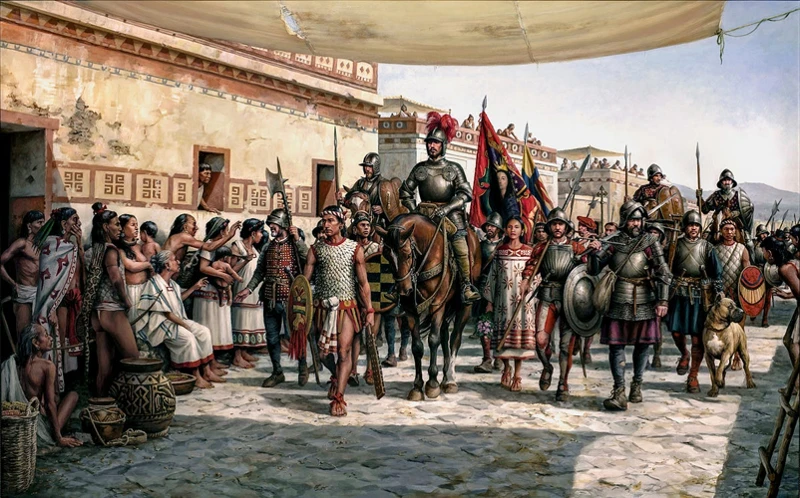
Hernán Cortés, the infamous Spanish conquistador, is a figure shrouded in both admiration and controversy. Born in Medellín, Spain, in 1485, Cortés was driven by a thirst for adventure, wealth, and glory. His early life was marked by restlessness and dissatisfaction, leading him to set sail for the New World in 1504, at the age of 19. Cortés proved to be a cunning and ambitious leader, gathering a loyal group of followers as he ventured into the unknown. Upon his arrival, Cortés encountered a vastly different world, with its diverse indigenous cultures and empires. With a combination of military tactics, diplomacy, and manipulation, he embarked on a mission to conquer and colonize, eventually setting his sights on the fabled Aztec Empire. Through strategic alliances with rival indigenous groups and exploiting internal divisions, Cortés orchestrated a series of conquests that led to the downfall of the Aztec Empire. However, his approach was not without brutality and controversy, as he implemented forced labor, imposed Spanish authority, and sought to convert the indigenous population to Christianity. As we delve deeper into Cortés’ motivations and methodology, we begin to understand the complexities and contradictions that surrounded this controversial historical figure.
2.1 Early Life and Motivations
|
Hernán Cortés, the man who would go on to lead the conquest of the Aztec Empire, was born in 1485 in Medellín, Spain. Raised in a noble family, Cortés received a good education and was exposed to the stories of great explorers and adventurers of his time. It is said that his interest in sailing and exploration was ignited at a young age, as he listened to tales of Christopher Columbus and his journeys to the New World. His early life and upbringing provided him with the foundation and motivation to seek his own adventures and make a name for himself. As a young man, Cortés yearned for a life of glory and wealth. He was ambitious and eager to establish his own legacy. In 1504, he set sail for the New World, joining an expedition to the island of Hispaniola (now the Dominican Republic and Haiti). This marked the beginning of his career as a conquistador, as he participated in various military campaigns and gained valuable experience in the struggles for imperial control in the Caribbean. Cortés was known for his cunning, strategic thinking, and charisma, traits that would serve him well in the years to come. His motivations were multi-faceted, including a desire for wealth, fame, and glory, as well as a sense of duty and adventure. He believed that by venturing to the New World, he could carve out a prosperous future for himself and make a name for Spain. Little did he know that his path would lead him to one of the greatest conquests in history. |
2.2 The Journey to the New World
The journey to the New World was no easy feat for Hernán Cortés and his expedition. In 1519, Cortés set sail from Cuba, determined to explore and conquer new lands. His fleet consisted of eleven ships and over 500 men, including soldiers, sailors, and craftsmen. They embarked on a treacherous voyage across the Atlantic Ocean, facing harsh weather conditions and the constant threat of shipwrecks. The journey lasted for several weeks, during which the crew battled sea sickness, shortages of food and water, as well as the constant fear of encountering hostile indigenous peoples.
Cortés’ fleet eventually reached the coast of Mexico, landing near the present-day city of Veracruz. This marked the beginning of a new chapter in the history of the New World, as Cortés and his men set foot on the land that would become the heart of the Aztec Empire. With a sense of curiosity and determination, they embarked on a perilous journey into the unknown, unsure of what lay ahead.
In preparation for their expedition, Cortés rallied his troops, reminding them of the riches they could gain and the glory they could achieve. He emphasized the importance of unity and obedience, knowing that they would face formidable challenges in the unfamiliar territory. The journey to the New World was fraught with danger, but it was also filled with the promise of adventure and discovery.
As they ventured further into the continent, Cortés and his men encountered various indigenous groups who provided them with valuable information about the Aztecs and their empire. These encounters, although sometimes hostile, were crucial in shaping Cortés’ understanding of the political dynamics and cultural landscape of the region.
The journey to the New World was not just a physical one for Cortés and his men; it was also a journey into the unknown, both geographically and culturally. They were about to enter a world vastly different from their own, one that would test their courage, resilience, and adaptability. Little did they know the monumental impact their arrival would have on the fate of the Aztec Empire and the course of history.
The Conquest Begins: Arrival in the Aztec Empire
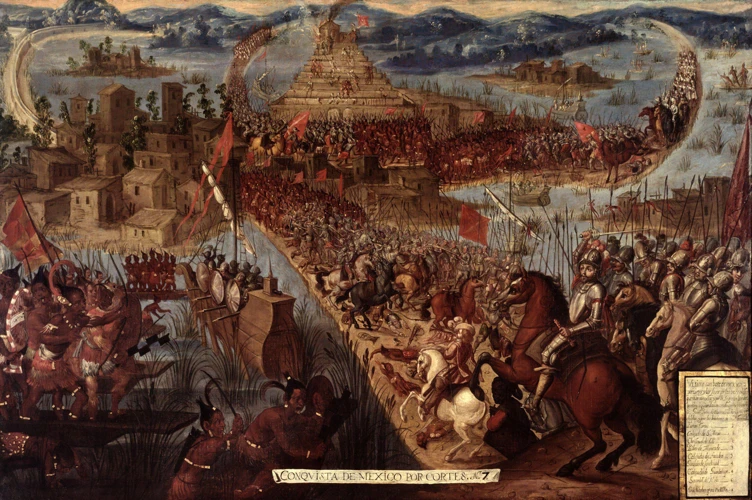
After a treacherous journey across the Atlantic, Hernán Cortés and his band of Spanish conquistadors finally arrived in the Aztec Empire in 1519. This marked the beginning of a monumental turning point in history. Cortés and his men were initially viewed with curiosity and cautious hospitality by the Aztec ruler, Moctezuma II. However, their true intentions soon became apparent. As they ventured deeper into the empire, Cortés sought alliances with rival indigenous groups who held grievances against the Aztecs. These alliances would prove crucial in the conquest to come. Cortés strategically utilized the devastating force of disease, such as smallpox, to his advantage, unknowingly bringing a deadly wave of illness that decimated the indigenous population, weakening the empire’s resistance. The arrival of Cortés and the Spanish marked the beginning of a conflict that would ultimately lead to the fall of the grand Aztec Empire. Let us explore the initial encounters, alliances, and the overlooked role of disease, unraveling the complex events that unfolded at this critical stage of the conquest.
3.1 Initial Encounters and Alliances
The initial encounters between Hernán Cortés and the Aztec Empire were marked by a complex web of alliances and diplomatic maneuvers. When Cortés and his forces first arrived in the region in 1519, they were met with curiosity and suspicion by the Aztecs. The Aztec ruler, Moctezuma II, initially sent gifts to Cortés, hoping to appease the Spanish newcomers. However, it became clear that Cortés had his eyes set on conquest rather than friendly relations.
Cortés, leveraging his military advantage and the Aztecs’ internal political tensions, sought to form alliances with rival indigenous groups who were discontent with Aztec rule. One such group was the Tlaxcalans, who had long been enemies of the Aztecs. Through a combination of military prowess, diplomacy, and promises of freedom from Aztec rule, Cortés was able to secure the support of the Tlaxcalans. This alliance was crucial in the later stages of the conquest.
Another important alliance was forged with La Malinche, a young Indigenous woman who became Cortés’ interpreter and advisor. La Malinche, also known as Doña Marina, played a pivotal role in facilitating communication between Cortés and the indigenous peoples, translating languages and cultures. She also provided valuable insight into local customs and helped navigate the complex political landscape of the region.
These initial alliances were instrumental in aiding Cortés’ expedition. They provided him with vital information about the Aztec empire, its military strategies, and its vulnerabilities. The Tlaxcalans, in particular, proved to be fierce warriors who fought alongside the Spanish in subsequent battles against the Aztecs.
The initial encounters and alliances established by Cortés played a crucial role in shaping the course of the conquest. From forming strategic partnerships with rival indigenous groups to gaining the assistance of skilled interpreters like La Malinche, Cortés was able to lay the groundwork for the eventual downfall of the Aztec Empire.
3.2 The Role of Disease
| The Role of Disease in the Fall of the Aztec Empire |
| The arrival of Hernán Cortés and his men in the Aztec Empire brought with them not only advanced weaponry and military tactics but also a devastating wave of disease. The indigenous people of Mesoamerica were no match for the diseases brought from Europe, to which they had no immunity. The most infamous of these diseases was smallpox, a highly contagious and deadly illness that ravaged the population. The Aztecs, having never encountered such diseases before, had no natural defenses or medical knowledge to combat them. As a result, the population was decimated, with some estimates suggesting that up to 90% of the indigenous population died from diseases in the decades following the arrival of the Spanish. The loss of such a large number of people had a catastrophic impact on the Aztec Empire. It weakened their military forces, disrupted their economy, and caused widespread panic and chaos. The Spanish conquistadors, unknowingly aided by disease, were able to exploit this weakened state and further their conquest. The role of disease in the fall of the Aztec Empire cannot be overstated, as it played a significant part in the ultimate downfall of this once-mighty civilization. |
3.3 The Fall of Other Indigenous Allies
As Hernán Cortés and his Spanish forces advanced in their conquest of the Aztec Empire, they formed alliances with various indigenous groups who were discontented with Aztec rule. These alliances were crucial in weakening the Aztecs’ hold on power. However, as the siege of Tenochtitlán intensified, some of these indigenous allies began to reconsider their loyalties. One such example is the Tlaxcalans, who had initially joined forces with Cortés against the Aztecs. Despite their initial cooperation, there were growing tensions between the Tlaxcalans and the Spaniards. The Tlaxcalans had their own ambitions and grievances against the Aztecs, and they saw an opportunity to gain power and autonomy in the aftermath of the conquest. Subsequently, they started to distance themselves from Cortés, and clashes between the Spanish and the Tlaxcalans became more frequent.
Similarly, other indigenous groups who had initially supported Cortés also began to have second thoughts. The Spaniards’ brutal tactics, unfair treatment, and disregard for the local customs and traditions left a bitter taste among the indigenous allies. These groups realized that they were merely pawns in the Spanish conquest and that their own interests were being overlooked. Some indigenous allies, such as the Huastecs and the Mixtecs, decided to turn against Cortés and join forces with the remaining Aztecs.
The arrival of diseases brought by the Spanish played a significant role in the fall of these indigenous allies. European diseases, to which the native populations had no immunity, spread rapidly and devastated these groups. Smallpox, measles, and other diseases decimated the indigenous communities, weakening their ability to fight back against the Aztecs and the Spaniards. The loss of their population and the collapse of their society further contributed to the unraveling of these alliances.
The fall of other indigenous allies marked a turning point in the conquest. It demonstrated the fragile nature of these alliances and the complexities of the conquest beyond the clash between the Aztecs and the Spanish. The shifting loyalties and the devastating impact of diseases highlighted the intricate dynamics at play during this tumultuous period in Mesoamerican history.
The Siege of Tenochtitlán: A Turning Point
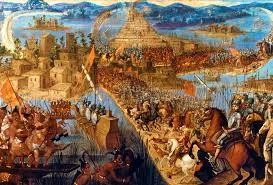
The Siege of Tenochtitlán marked a crucial turning point in the conquest of the Aztec Empire by Hernán Cortés and his Spanish forces. This epic battle was a culmination of strategic warfare and political maneuvering that would determine the fate of the empire. Cortés, with the help of his indigenous allies and dissident groups, planned and executed a meticulously organized assault on the capital city of Tenochtitlán. The battle strategies employed by Cortés, such as blockades and targeted attacks on key areas, put significant pressure on the Aztec defenders. Despite their bravery and resilience, the Aztecs faced immense difficulties, including the loss of their leader, Moctezuma II, who was captured by the Spanish. However, it was not just military might that spelled the end for the Aztec Empire. The involvement of indigenous allies and dissident groups proved instrumental in destabilizing the empire from within. These internal factors, combined with the relentless onslaught from the Spanish forces, ultimately led to the fall of Tenochtitlán and the end of the Aztec Empire as an independent political entity. The Siege of Tenochtitlán stands as a critical moment in history, showcasing the decisive power of strategy, alliances, and internal dissent in shaping the course of conquest.
4.1 The Battle Strategies of Cortés
Cortés employed a variety of battle strategies during his conquest of the Aztec Empire, which played a crucial role in his ultimate success. One of his key strategies was the use of diplomacy and manipulation to forge alliances with indigenous groups who were discontent with Aztec rule. Cortés capitalized on pre-existing tensions and grievances, convincing these groups to join him in his campaign against the empire. This effectively enabled him to gather a formidable force by leveraging the power of indigenous allies who shared a common goal of overthrowing Aztec dominance.
Another significant aspect of Cortés’ strategy was his tactical mastery in warfare. He adapted his tactics to the unique geographical and cultural circumstances of Mesoamerica. The use of cavalry, firearms, and advanced armor provided the Spanish with a technological advantage over the Aztecs, who primarily relied on traditional weapons such as spears and arrows. Cortés’ military expertise allowed him to exploit weaknesses in Aztec defensive structures and engage in strategic maneuvers.
Cortés understood the importance of psychological warfare in his strategy. He strategically employed fear and intimidation to demoralize the Aztec warriors. For example, the arrival of Spanish conquistadors astride horses, which were unfamiliar and awe-inspiring to the Aztecs, created an element of surprise and psychological impact. Cortés also utilized his alliances with indigenous groups to spread rumors about Spanish invincibility, further sowing fear and doubt among the Aztec warriors.
Cortés was not only a skilled military tactician but also a skilled negotiator. He often employed diplomacy and manipulation to maneuver through challenging situations. One example of this was his capture of Moctezuma II, the ruler of the Aztec Empire, which was a turning point in the conquest. By taking Moctezuma as a hostage, Cortés effectively neutralized the Aztec leadership and gained control over the capital city, Tenochtitlán.
Cortés’ battle strategies were instrumental in the conquest of the Aztec Empire. His ability to forge alliances, adapt his tactics to the environment, employ psychological warfare, and utilize negotiation skills proved to be crucial in the ultimate downfall of the powerful Aztec civilization. The combination of military might and strategic thinking enabled Hernán Cortés to accomplish what was once considered an insurmountable task in the annals of history.
4.2 The Role of Indigenous Allies and Dissident Groups
One of the pivotal factors in the conquest of the Aztec Empire was the role played by indigenous allies and dissident groups. Hernán Cortés, the Spanish conquistador, recognized the potential power in aligning with native peoples who held grievances against the Aztec rulers. These indigenous allies, such as the Tlaxcalans, provided crucial military support to Cortés and his forces. Their knowledge of the land, language, and warfare tactics proved invaluable in the conquest. The dissident groups within the empire, who were opposed to Aztec domination, also played a significant role. One notable example is the capture and imprisonment of Moctezuma II by the indigenous group known as the Cempoalans. This weakened the Aztec leadership and created a power vacuum that further facilitated the Spanish conquest. However, it is important to note that the indigenous allies and dissident groups were not solely motivated by a desire to see the downfall of the Aztecs. They also had their own motives and interests, including the hope of reclaiming lost territories, asserting their own power, and obtaining material benefits. The complex dynamics among the various indigenous groups and their relationships with the Spanish forces greatly influenced the outcome of the conquest.
4.3 The Capture of Moctezuma II
When Hernán Cortés and his forces arrived in Tenochtitlán, they were met with initial resistance from the Aztec Empire. However, despite the hostility, Moctezuma II, the reigning emperor of the Aztecs, decided to meet Cortés personally. This decision proved to be a fateful one. Moctezuma II was captured by Cortés and held hostage within his own palace. This move was significant as it effectively destabilized the Aztec leadership and created divisions within the empire. Cortés used Moctezuma II as a puppet ruler, hoping to maintain control over the city. However, the situation quickly deteriorated as the Aztecs resented their captured leader and grew increasingly hostile towards the Spanish. Moctezuma II’s capture also fueled the fire of resistance among the Aztec population, who saw Cortés’ actions as an act of disrespect towards their ruler and their civilization. The capture of Moctezuma II marked a turning point in the conquest, as it further fueled the anger and determination of the Aztecs to reclaim their city and drive out the Spanish invaders. Ultimately, this event played a crucial role in the final collapse of the Aztec Empire and the fall of Tenochtitlán.
Sources:
– Smith, Michael E. “The Aztecs.” Wiley-Blackwell, 2003.
– Hassig, Ross. “Aztec Warfare: Imperial Expansion and Political Control.” University of Oklahoma Press, 1995.
The End of an Empire: Fall of Tenochtitlán
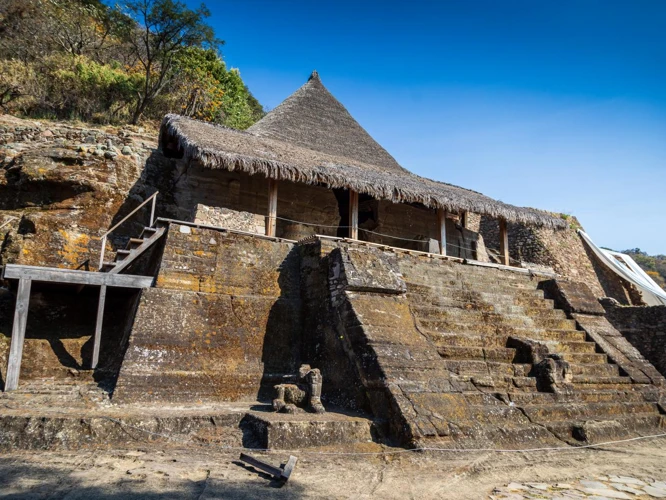
The Fall of Tenochtitlán marked the final chapter in the demise of the Aztec Empire. Hernán Cortés and his Spanish forces, along with their indigenous allies, initiated a siege on the capital city in 1521. The once-magnificent Tenochtitlán, with its sprawling temples and bustling markets, was now under attack. The Spaniards employed devastating tactics, including the destruction of aqueducts that supplied the city with water, cutting off a vital resource. They also utilized cannons and superior weaponry to breach the city’s walls. Indigenous allies, who had joined forces with Cortés against the Aztecs, played a crucial role in the siege. The relentless assault ultimately led to the capture and subsequent death of the Aztec emperor, Cuauhtémoc. The destruction wrought upon Tenochtitlán was immense, laying waste to a city that had once been the center of a mighty empire. In its place, the Spaniards established Mexico City, marking the beginning of Spanish colonization. The fall of Tenochtitlán not only signaled the end of a powerful empire but also forever altered the course of history in the Americas. For further insight into the cultural suppression and religious implications of the conquest, visit our article on the role of religion and cultural suppression in the fall of the Aztec Empire.
5.1 The Final Siege on Tenochtitlán
The Final Siege on Tenochtitlán marked the culmination of Hernán Cortés’ conquest of the Aztec Empire. After a series of battles and diplomatic maneuvers, Cortés and his Spanish forces, along with their indigenous allies, found themselves at the doorstep of the magnificent Aztec capital. The siege began in May 1521 and lasted for several months, with both sides fiercely fighting for control of the city. The Spanish employed their superior weaponry and military tactics to their advantage, while the Aztecs defended their homeland with unparalleled bravery. The Spanish forces faced numerous challenges during the siege, as they had to overcome the city’s formidable fortifications, including its intricate network of canals and causeways. The fighting was intense and brutal, with casualties mounting on both sides. Despite the valiant resistance of the Aztecs, the Spanish slowly gained the upper hand.
One of the turning points of the siege was the capture of Cuauhtémoc, the last Aztec emperor, who had been leading the defense of Tenochtitlán. His capture weakened the morale of the Aztecs, and they realized that their cause was near lost. The Spanish pressed their advantage, launching relentless attacks on the city. They destroyed buildings, looted treasures, and caused great devastation. As the siege wore on, the Aztecs faced starvation and disease, further weakening their ability to resist. Finally, on August 13, 1521, Tenochtitlán fell to the Spanish forces. The once-great capital of the Aztec Empire lay in ruins.
The fall of Tenochtitlán was a profoundly significant event in history, marking the end of the Aztec Empire and the beginning of Spanish colonization in the region. The conquest of Tenochtitlán paved the way for the establishment of New Spain, which would become the center of Spanish power in the Americas. The destruction and colonization that followed would have lasting consequences for the indigenous peoples of Mesoamerica.
5.2 Destruction and Colonization
The destruction and colonization of the Aztec Empire was a devastating outcome of the conquest led by Hernán Cortés and his Spanish forces. After a lengthy siege and numerous battles, the city of Tenochtitlán, the capital of the Aztec Empire, fell to the conquistadors in 1521. The Spanish wasted no time in asserting their dominance and instituting a system of colonization. The city was ravaged and much of its infrastructure was destroyed, including its grand temples and palaces. The Spanish then began a process of establishing control over the land and its resources. They enforced tribute payments from the remaining indigenous population and introduced new systems of governance and law. The colonization of the Aztec Empire brought about significant cultural and social changes. The Spanish introduced their own language, religion, and customs, suppressing Aztec traditions and beliefs. The indigenous population suffered greatly, not only from the physical destruction wrought by the conquest but also from diseases brought by the Spanish, to which they had little immunity. This resulted in a decline in population and the loss of indigenous knowledge and practices. The consequences of the destruction and colonization of the Aztec Empire were profound and far-reaching, reshaping the landscape of Mesoamerica for centuries to come.
5.3 The Role of Religion and Cultural Suppression
During the conquest of the Aztec Empire, religion played a significant role in both the downfall of the Aztecs and the subsequent colonization by the Spanish. The Aztecs practiced a complex polytheistic religion centered around the worship of numerous gods, rituals, and sacrifices. The Spanish viewed these practices as pagan and idolatrous, and they sought to suppress and eradicate the Aztec religion as part of their conquest.
One of the strategies employed by the Spanish was to convert the indigenous population to Christianity. They established missions and forcefully converted many Aztecs, destroying their temples and replacing them with churches. The Spanish sought to impose their religious beliefs and practices on the native population, erasing the Aztec religious and cultural identity.
The suppression of Aztec religion had devastating consequences for the indigenous people. It resulted in the loss of their spiritual beliefs, cultural practices, and social structures that had been integral to their way of life for centuries. The Spanish aimed to control every aspect of the Aztec society, including their religious practices, in order to exert dominance and establish control over the conquered population.
The role of religion and cultural suppression in the downfall of the Aztec Empire cannot be understated. It was a deliberate and calculated tactic employed by the Spanish to assert their authority and reshape the conquered society in their own image. The effects of this cultural suppression reverberated for generations, leading to the loss and erasure of traditional knowledge, practices, and beliefs.
References:
– Understanding the Fifth House in Astrology
Legacy and Consequences
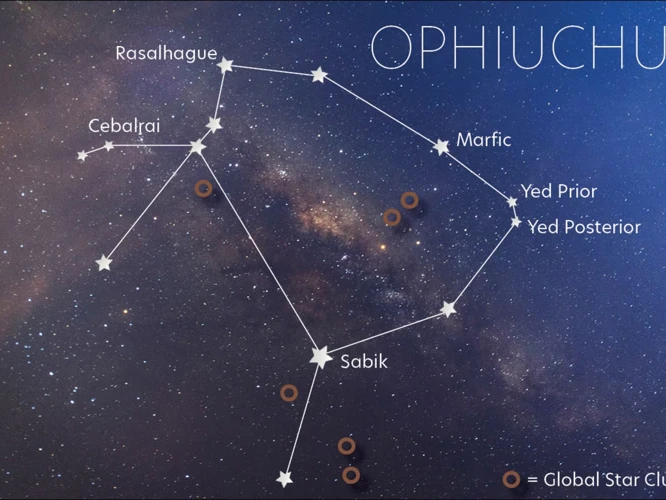
Legacy and Consequences
The fall of the Aztec Empire marked a turning point in history, with far-reaching consequences for both the indigenous peoples of Mesoamerica and the European conquerors. The impact on indigenous cultures and peoples was profound. The conquest led to the loss of land, resources, and autonomy for many indigenous communities, who were subjected to Spanish rule and forced labor. The introduction of new diseases, such as smallpox, decimated the indigenous population, leaving a lasting demographic impact. The Spanish colonization also brought about cultural suppression and religious conversion, as the Aztec religion and practices were progressively replaced by Catholicism. Native languages were suppressed, and many aspects of indigenous culture were suppressed or altered. Historical accounts and perspectives play a crucial role in shaping our understanding of these events. Primary sources, such as the writings of Spanish chroniclers and indigenous accounts, provide valuable insights into the conquest and its aftermath. However, it is important to critically analyze these accounts, considering the biases and perspectives of the authors. The legacy of the Aztec Empire and its conquest continues to be studied and debated, shedding light on the complexities and lasting effects of this pivotal moment in history.
6.1 The Impact on Indigenous Peoples and Cultures
The impact of the conquest on indigenous peoples and cultures in the wake of the fall of the Aztec Empire was profound and far-reaching. The arrival of the Spanish and the subsequent colonization had devastating consequences for the native populations of Mesoamerica. Many indigenous communities were decimated by the introduction of diseases brought by the Europeans, to which they had no immunity. Diseases such as smallpox, measles, and influenza spread rapidly, leading to the loss of countless lives and the collapse of entire communities. The social fabric of these societies was torn apart, with traditional leadership structures undermined and cultural practices disrupted.
The Spanish conquerors imposed their own political, economic, and religious systems, leading to the erosion of indigenous identities and traditions. The native peoples were subjected to forced labor and exploitation, with their lands and resources seized by the colonizers. The Spanish implemented a system known as encomienda, which granted Spanish settlers the right to use indigenous labor in exchange for protection and Christianization. This system created a cycle of oppression and cultural assimilation that persisted for generations.
Indigenous languages and belief systems were suppressed, as the Spanish sought to impose Catholicism and eradicate native religions. Places of worship and sacred sites were destroyed or repurposed, erasing centuries of indigenous spiritual practices. The cultural heritage of the indigenous peoples was devalued and marginalized, as the Spanish language and European customs took precedence.
The profound impacts of the conquest on indigenous peoples and cultures are still felt today. Many indigenous communities continue to face social and economic inequalities, and efforts to preserve and revitalize their languages and cultural practices are ongoing. The legacy of the conquest serves as a reminder of the resilience and perseverance of indigenous peoples, as they navigate the complexities of a world shaped by colonialism.
6.2 Historical Accounts and Perspective
When examining the historical accounts and perspectives surrounding the fall of the Aztec Empire, it is crucial to recognize the inherent biases and limitations of the sources available. The primary accounts of the conquest were written by Spanish conquistadors and their associates, such as Bernal Díaz del Castillo and Gonzalo Fernández de Oviedo. These firsthand narratives often paint a picture of heroic conquest and emphasize the bravery and accomplishments of the Spanish forces. However, it is important to approach these accounts with a critical eye, as they reflect the perspectives and agendas of the conquerors.
Over time, additional sources have emerged that provide alternate viewpoints. Indigenous accounts, such as the Florentine Codex compiled by Nahua historians, offer insights into the Aztec experience and provide a more balanced perspective. These accounts shed light on the resistance put up by the Aztecs, the devastation they faced, and the loss of their cultural heritage. Archaeological discoveries have allowed researchers to piece together a more comprehensive understanding of the events surrounding the fall of the Aztec Empire.
The interpretation of these historical accounts and perspectives continues to evolve as scholars strive to uncover hidden truths and challenge prevailing narratives. The complex nature of history necessitates examining multiple sources and cross-referencing information to obtain a more complete picture. By analyzing a wide range of viewpoints, historians can strive to reconcile conflicting narratives and gain a deeper understanding of the multifaceted nature of this pivotal moment in history. By delving into these varied historical accounts and perspectives, we can gain a more nuanced understanding of the fall of the Aztec Empire and the impact it had on both the conquerors and the conquered.
Conclusion

- The Impact on Indigenous Peoples and Cultures: The fall of the Aztec Empire had a devastating impact on the indigenous peoples of Mesoamerica. The conquest led to the loss of countless lives, the destruction of cultural heritage, and the suppression of traditional practices. Many indigenous groups faced discrimination and marginalization under Spanish rule, and their way of life was forever changed. The Aztec civilization, with its complex social structure, advanced agricultural systems, and vibrant artistic traditions, was irrevocably altered.
- Historical Accounts and Perspectives: The conquest of the Aztec Empire has been documented through various historical accounts, but it is important to acknowledge that these narratives are often biased and reflect the perspectives of the conquerors. The primary sources include the writings of Spanish chroniclers, such as Bernal Díaz del Castillo and Bernardino de Sahagún, who provided firsthand testimonies of the events. However, it is crucial to consider indigenous perspectives and oral histories to gain a more comprehensive understanding of this period in history.
Despite the tragic consequences of the fall of the Aztec Empire, it is impossible to deny the lasting impact it has had on the world. The conquest marked the beginning of European colonization in the Americas and paved the way for the spread of Spanish language, religion, and culture. The exchange of goods, ideas, and people between Europe and the Americas shaped the course of history and created a diverse and complex intermingling of cultures. The fall of the Aztec Empire remains a significant event that continues to be studied and analyzed, reminding us of the complexities and power dynamics inherent in the process of conquest and colonization.
Frequently Asked Questions

1. What was the significance of the name “Aztec”?
The name “Aztec” was derived from the word “Aztlan,” which means “place of the herons” in Nahuatl, the Aztec language. It was believed to be the ancestral homeland of the Aztecs, although its exact location remains uncertain.
2. How did the Aztecs build their impressive city of Tenochtitlán?
Tenochtitlán was built on an island in Lake Texcoco, and the Aztecs creatively constructed a series of elevated causeways to connect the city to the mainland. They also developed a sophisticated water management system, including the use of canals and aqueducts.
3. What were the main agricultural practices of the Aztecs?
The Aztecs engaged in diverse agricultural practices, with their most innovative method being the chinampas. These were floating gardens made from mud, reeds, and vegetation, allowing for the cultivation of crops such as corn, beans, and squash. They also practiced terrace farming in hilly areas.
4. How did the Aztecs view warfare and sacrifice?
Warfare was fundamental to the Aztec culture, as they believed it was essential for acquiring prisoners for sacrifice and expanding their empire. Sacrifice, both human and animal, played a crucial role in their religious beliefs, with the Aztecs believing it was necessary to appease their gods.
5. Who were the powerful gods worshipped by the Aztecs?
The Aztecs worshipped a multitude of gods, with some of the most prominent ones being Huitzilopochtli, the god of war and the sun, Tlaloc, the god of rain and fertility, and Quetzalcoatl, the feathered serpent god associated with wisdom and knowledge.
6. What was the role of women in Aztec society?
While Aztec society was largely patriarchal, women held important roles. They played key roles in religious ceremonies, had the ability to own and inherit property, and were involved in the production of textiles and crafts.
7. How did Hernán Cortés gain the support of indigenous allies?
Cortés was able to exploit existing rivalries between indigenous groups and the Aztecs. He formed alliances with various tribes who were resentful of Aztec dominance, offering them the opportunity to overthrow their Aztec oppressors and gain power in return.
8. What role did disease play in the fall of the Aztec Empire?
Disease, especially smallpox, brought by the Spanish conquistadors played a significant role in the fall of the Aztec Empire. The Aztecs had no natural immunity to these European diseases, and it caused devastating epidemics that weakened the population and further destabilized the empire.
9. How did the capture of Moctezuma II impact the Aztec Empire?
When Cortés and his forces captured Moctezuma II, the Aztec emperor, it created a power vacuum and deep divisions within the leadership of the empire. Moctezuma’s capture undermined the Aztecs’ morale and credibility, making it easier for the Spanish conquistadors to exploit the situation.
10. What were the long-term consequences of the fall of the Aztec Empire?
The fall of the Aztec Empire led to Spanish colonization in the region, resulting in the imposition of a new culture, language, and religion. It also had a profound impact on indigenous peoples, their way of life, and their social structures, leading to the loss of cultural heritage and the domination of European influence.
References
Frequently Asked Questions

1. What factors led to the rise of the Aztec Empire?
The rise of the Aztec Empire can be attributed to several factors such as military conquests, strategic alliances, and effective governance. The Aztecs expanded their territory through military campaigns and formed alliances with neighboring city-states. Their centralized government and efficient administration also played a crucial role in their rise to power.
2. How did Aztec society and culture differ from other indigenous civilizations?
Aztec society was highly stratified, with a ruling elite composed of nobles, priests, and warriors. They placed great importance on warfare and religious rituals, often engaging in human sacrifices. The Aztecs also had a complex agricultural system, advanced architecture, and a sophisticated calendar. Their vibrant art and intricate craftsmanship set them apart from other civilizations.
3. What motivated Hernán Cortés to embark on his journey to the New World?
Hernán Cortés was driven by various motivations, including the thirst for wealth and glory, as well as a desire to spread Christianity. He saw the New World as an opportunity for personal enrichment, hoping to find precious metals and establish colonies for Spain. Cortés was also influenced by the prevailing spirit of exploration and conquest during the Age of Discovery.
4. How did Hernán Cortés establish alliances with indigenous groups upon his arrival?
Upon his arrival in the Aztec Empire, Cortés recognized the importance of forging alliances with indigenous groups who were dissatisfied with Aztec rule. He capitalized on existing rivalries and grievances to gain native allies, providing them with military support and promises of increased autonomy. These alliances proved pivotal in the subsequent conquest of the Aztec Empire.
5. What role did diseases play in the downfall of the Aztec Empire?
Diseases brought by the Europeans, such as smallpox, played a significant role in the downfall of the Aztec Empire. The Aztecs had no previous exposure to these diseases, and their lack of immunity resulted in devastating epidemics that decimated their population. The spread of diseases weakened the empire and made it more susceptible to Spanish conquest.
6. How did Cortés’s battle strategies contribute to the siege of Tenochtitlán?
Cortés employed various battle strategies to besiege Tenochtitlán. He strategically cut off the city’s supplies and launched devastating attacks on key infrastructure. Cortés also utilized the element of surprise and exploited internal divisions within the empire. These tactics, combined with the assistance of indigenous allies, played a crucial role in the eventual fall of Tenochtitlán.
7. What were the consequences of the fall of Tenochtitlán and the colonization of the Aztec Empire?
The fall of Tenochtitlán marked the end of the Aztec Empire and had far-reaching consequences for both the indigenous peoples and European colonizers. The colonization led to the exploitation of the region’s resources, forced labor, and the imposition of Christianity. Indigenous cultures were suppressed, and their lands were taken over by the Spanish, resulting in a lasting legacy of cultural loss and societal upheaval.
8. How did the fall of the Aztec Empire impact other indigenous peoples and cultures?
The fall of the Aztec Empire had a profound impact on other indigenous peoples and cultures in the region. The conquest of the Aztecs set a precedent for further European colonization and expansion, leading to the loss of autonomy and cultural assimilation for many native groups. It also sparked resistance movements and shaped the future dynamics of indigenous-European relations in the Americas.
9. What are some different historical accounts and perspectives on the conquest of the Aztec Empire?
There are various historical accounts and perspectives on the conquest of the Aztec Empire. Spanish conquistadors like Cortés documented their own experiences, often emphasizing their achievements and justifying their actions. Indigenous accounts, such as the Florentine Codex, provide alternative perspectives and shed light on the devastating impact of colonization on native populations. Modern historians analyze these sources to create a more comprehensive understanding of this pivotal event in history.
10. What is the lasting legacy of the fall of the Aztec Empire?
The fall of the Aztec Empire left a lasting legacy in terms of culture, politics, and society. It marked a turning point in the history of the Americas, shaping the course of European colonization and the subsequent development of the continent. The cultural fusion between indigenous and European elements influenced the formation of new societies, while the scars of colonization continue to impact indigenous communities today.







